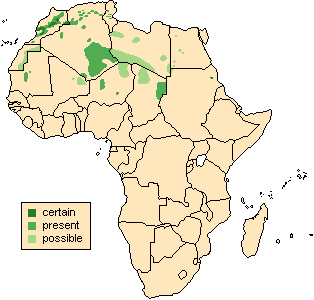![]() Return
to Artiodactyla
Return
to Artiodactyla
Classification
|
 Ammotragus
lervia
Ammotragus
lervia
Aoudad, Barbary sheep
![]()
Taxonomy
 |
 |
 |
Click on the pictures above for a larger view of the
photographs
|
||
General Characteristics
Body Length: 130-165 cm / 4.3-5.5 ft.
Shoulder Height: 75-110 cm / 2.5-3.7 ft.
Tail Length: 15-20 cm / 6-8 in.
Weight: 30-145 kg / 66-319 lb.The short, bristly outer coat is reddish to sandy brown in colour. The underparts are moderately lighter. Both sexes have a heavy fringe of hair on their throat, although in males this extends down the neck to encompass the chest and front legs. The tail is also fringed. The body is quite thick and sturdy. The thick, triangular-based horns are found in both sexes, although they are slightly larger in males. The horns have numerous fine rings, although in older individuals these may be worn down, causing the horn surface to look smooth. They curve in a semi-circle over the back, up to 55 cm / 22 inches.
Ontogeny and Reproduction
Gestation Period: 160 days.
Young per Birth: 1, rarely up to 3.
Weaning: At 3-4 months.
Sexual Maturity: After 18 months.
Life span: 20 years.Although breeding can occur throughout the year, there is a peak from September to November, with the subsequent young being born from March to May. Females may give birth twice per year. Newborns are able to negotiate the rocky hills almost immediately after birth.
Ecology and Behavior
Like most desert dwellers, the aoudad is most active in the cooler hours of dawn and dusk, seeking shade and shelter during the day. Aoudad are exceptionally sure-footed and have such jumping power that they can clear a 2 meter / 6.6 foot obstacle with ease from a standing start. The lack of vegetation for cover in their habitat has caused the aoudad to conceal itself by freezing in the presence of danger. Although they can generally obtain all needed moisture from their food, if water is available aoudad drink and wallow liberally.Family group: Generally solitary or in small groups.
Diet: Sparse grasses, bushes, acacia, lichens.
Main Predators: Leopard, caracal.
Distribution
Rocky arid mountains in isolated pockets throughout northern Africa.

Range Map (Redrawn from Shackleton, 1997)
Conservation Status
The aoudad is classified as a vulnerable species by the IUCN (1996). A. l. ornatus, the Egyptian barbary sheep, is believed to be extinct.
Remarks
Although this sheep is becoming more and more difficult to find in its native North Africa, introduced populations in Spain and the southern United States are flourishing. Indeed, they have become so prosperous in America that it is feared they may start infringing on the habitat and resources of the indigenous desert bighorn sheep. Aoudad (pronounced "aOO-dad" or "OW-dad") is the name for this sheep used by the Berbers, a North African tribe. Ammos (Greek) sand; tragos (Greek) a goat: referring to the sand-coloured coat. Lervia, from the wild sheep of northern Africa described as "Lerwee" be the Rev. T. Shaw in his "Travels and Observations" relating to several parts of Barbary and the Levant.
Literature Cited
Haas, G. 1990. Barbary sheep (Genus Ammotragus). In Grzimek's Encyclopedia of Mammals. Edited by S. P. Parker. New York: McGraw-Hill. Volume 5, pp. 538-540.Nowak, R. M. [editor]. 1991. Walker's Mammals of the World (Fifth Edition). Baltimore: The Johns Hopkins University Press.
Shackleton, D. M. [Editor] and the IUCN/SSC Caprinae Specialist Group. 1997. Wild Sheep and Goats and their Relatives. Status Survey and Action Plan for Caprinae. IUCN: Gland, Switzerland and Cambridge, UK.
Wilson, D. E., and D. M. Reeder [editors]. 1993. Mammal Species of the World (Second Edition). Washington: Smithsonian Institution Press. Available online at http://nmnhwww.si.edu/msw/
Return to Artiodactyla

![]()
© Brent Huffman, www.ultimateungulate.com |
|
|